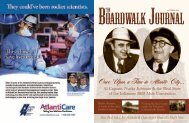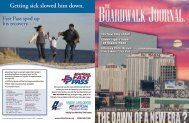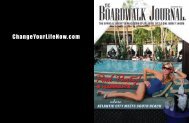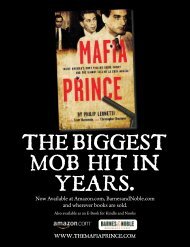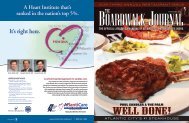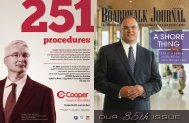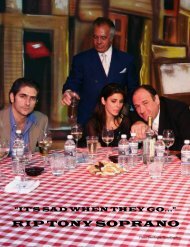in your family's history with AtlantiCare Primary Care Plus.
in your family's history with AtlantiCare Primary Care Plus.
in your family's history with AtlantiCare Primary Care Plus.
Create successful ePaper yourself
Turn your PDF publications into a flip-book with our unique Google optimized e-Paper software.
EDDiE AND ThE CruiSErS<br />
30 Years Down the Pike By Bill kelly<br />
It’s been thirty years s<strong>in</strong>ce Hollywood came to the Jersey Shore to film eddie and<br />
the Cruisers, but it’s still fondly remembered for document<strong>in</strong>g the times and the<br />
places that were very special to a lot of people.<br />
Set <strong>in</strong> the early 1960’s and filmed on location on the Ocean City (NJ) beach and<br />
boardwalk as well as Tony Marts nightclub <strong>in</strong> Somers Po<strong>in</strong>t, eddie and the Cruisers<br />
caught the spirit of early rock and roll and captured the basic landscape of a<br />
bygone era—a landscape that for the most part, no longer exists.<br />
eddie and the Parkway Cruisers first made their appearance <strong>in</strong> literature <strong>in</strong> the<br />
1980 novel, “eddie & the Cruisers” by P. F. Kluge.<br />
From Berkeley Heights, New Jersey, Paul Frederick “P.F.” Kluge attended Kenyon<br />
College <strong>in</strong> Gambier, Ohio, where he now teaches creative writ<strong>in</strong>g. Shortly after<br />
graduat<strong>in</strong>g, Kluge landed a job teach<strong>in</strong>g at V<strong>in</strong>eland High School <strong>in</strong> South<br />
Jersey, and from there, frequently wandered down to the Jersey Shore where he<br />
discovered a burgeon<strong>in</strong>g rock & roll scene. The music scene <strong>in</strong>spired him to write<br />
the story of a typical Jersey Shore bar band that, on the verge of break<strong>in</strong>g out<br />
and mak<strong>in</strong>g the big time, ends tragically when the lead s<strong>in</strong>ger dies <strong>in</strong> a suicide<br />
crash off the Ocean City causeway bridge.<br />
The book wasn’t a bestseller but one copy found its way <strong>in</strong>to the hands of Mart<strong>in</strong><br />
Davidson, the Hollywood producer of The Lords of Flatbush, the movie that first<br />
<strong>in</strong>troduced us to Sylvester Stallone and Henry W<strong>in</strong>kler. Davidson saw the movie <strong>in</strong><br />
it, and purchased the film rights <strong>with</strong> his own money. Us<strong>in</strong>g his literary licenses,<br />
Davidson made some m<strong>in</strong>or variations <strong>in</strong> the script but kept the basic story and<br />
ma<strong>in</strong> characters the same. In the book, eddie’s <strong>in</strong>spiration is the sentimental<br />
romantic Walt Whitman, who Davidson replaced <strong>with</strong> the radical eccentric Arthur<br />
Rimbaud. Instead of Leaves of Grass, the Cruiser’s masterpiece is Season <strong>in</strong> Hell,<br />
giv<strong>in</strong>g it more of a Doors’ psychedelic edge.<br />
Mart<strong>in</strong> Davidson has said that his <strong>in</strong>spiration for the film came from a desire to<br />
“get all my feel<strong>in</strong>gs about the music of the last 30 years of rock music <strong>in</strong>to it”. He<br />
wrote the screenplay<br />
<strong>with</strong> his wife Arlene<br />
and decided to use<br />
a Citizen Kane-style<br />
story structure, “That<br />
was <strong>in</strong> my head: the<br />
search.”<br />
58 | The Boardwalk Journal | April 2013<br />
Although not <strong>in</strong><br />
the book or <strong>in</strong> the<br />
orig<strong>in</strong>al script, when<br />
the location scouts<br />
and set designers<br />
came pok<strong>in</strong>g around<br />
for a place to shoot<br />
the film, they were<br />
directed to Tony<br />
Marts Café <strong>in</strong> Somers<br />
Po<strong>in</strong>t, one of the<br />
last of the old rock<br />
& roll nightclubs still<br />
stand<strong>in</strong>g at the time.<br />
Anthony Marotta,<br />
fresh from Mas<strong>in</strong>a,<br />
Sicily, made his<br />
way to Atlantic<br />
City and saved money he<br />
made from sell<strong>in</strong>g hot dogs<br />
and sandwiches on the<br />
boardwalk at St. James<br />
Place. When the opportunity<br />
arose—just after the Storm<br />
of ’44—Marotta purchased<br />
the old Schick’s Hotel and<br />
Rathskeller on Bay Avenue<br />
<strong>in</strong> Somers Po<strong>in</strong>t. expand<strong>in</strong>g<br />
the tavern bar on the first<br />
floor and add<strong>in</strong>g a stage,<br />
Tony brought <strong>in</strong> acts like<br />
Bill Haley and the Comets, Conway Twitty,<br />
Duane eddie and Mitch Ryder. Tony<br />
featured all k<strong>in</strong>ds of enterta<strong>in</strong>ment and<br />
a variety of music, as long as the people<br />
liked it. A second stage was added to<br />
present cont<strong>in</strong>uous live enterta<strong>in</strong>ment so<br />
when one band concluded another would<br />
beg<strong>in</strong>, keep<strong>in</strong>g the dance floor busy.<br />
Featur<strong>in</strong>g travel<strong>in</strong>g record<strong>in</strong>g artists, Tony Marts ushered <strong>in</strong> early rock & roll and<br />
even Las Vegas style headl<strong>in</strong>e acts as well as local bar bands <strong>in</strong> its heyday. In<br />
1965, Conway Twitty was the most popular attraction and the house band was<br />
Levon & the Hawks (who later became The Band that often accompanied Bob<br />
Dylan after he “went electric”).<br />
But by the summer of 1982, Tony Marts was a shell of its old self. The music was<br />
w<strong>in</strong>d<strong>in</strong>g down, disco had changed the styles, DJs were cheaper, and Tony was<br />
tired. So when the right deal came along, Tony took it. Tony decided to sell the<br />
place to an attorney who had plans to level the old clapboard build<strong>in</strong>g and build a<br />
disco nightclub, as he had done <strong>with</strong> Bayshores across the street.<br />
It was to be the last summer before the music died when this Hollywood film crew<br />
comes to town look<strong>in</strong>g for a rock & roll nightclub to make a movie. When they saw<br />
Tony Marts, looked at the scrapbook of bands that had played there, looked at the<br />
walls and soaked <strong>in</strong> the club’s motif, which had been simmer<strong>in</strong>g <strong>in</strong> the booze for<br />
decades, they knew Tony Marts was the place. Davidson wanted to close the place<br />
for two weeks and make a movie there, and when Tony told them how much it<br />
would cost, they made a deal.<br />
A cast<strong>in</strong>g call went out for teenagers to be <strong>in</strong> the audience and for bit parts, and<br />
hundreds of people got called and became part of the show. “Th<strong>in</strong>k 1962” they<br />
were told, the year the movie was set, and the clothes and hairstyles that were<br />
required.<br />
eddie, the leader of the Cruisers, drove a ’57 Chevy.<br />
When the ma<strong>in</strong> stars showed up, many of the extras didn’t recognize them. Now,<br />
three decades later, they’re familiar faces <strong>with</strong> household names—Tom Berenger,<br />
Michael Pare, Helen Schneider, Joe Pantoliano, Matthew Laurence and ellen<br />
Bark<strong>in</strong>.<br />
Berenger plays Frank Ridgeway, aka “Wordman,” a school teacher character based<br />
on author Kluge, who is work<strong>in</strong>g the summer as a Tony Marts custodian and<br />
recruited <strong>in</strong>to the Parkway Cruisers, the band led by eddie Wilson, played by the<br />
charismatic Michael Pare. “Words and music,” eddie says, “that’s what we need.”<br />
In the movie, Berenger’s Ridgeway is push<strong>in</strong>g a broom around Tony Mart’s dance




